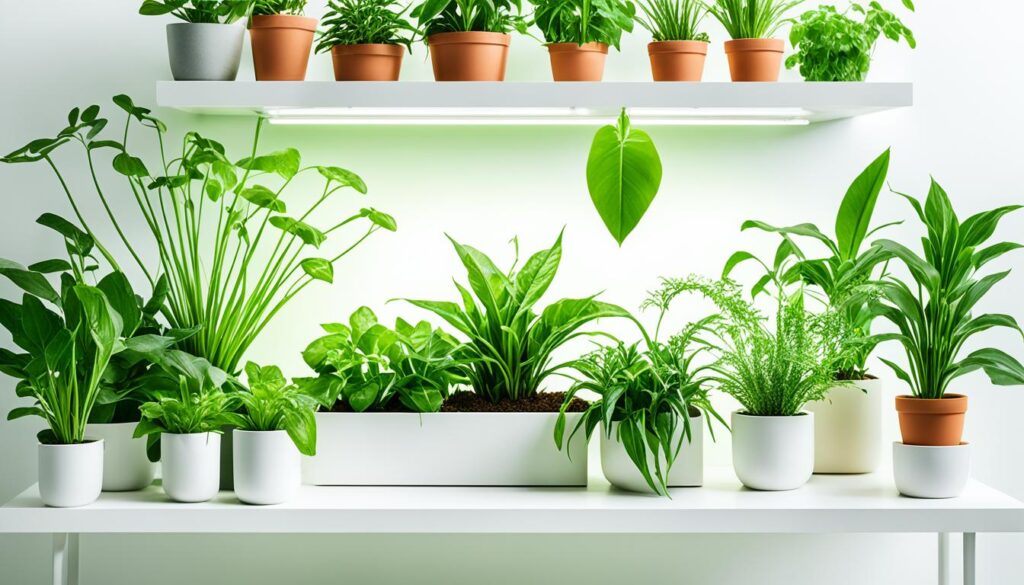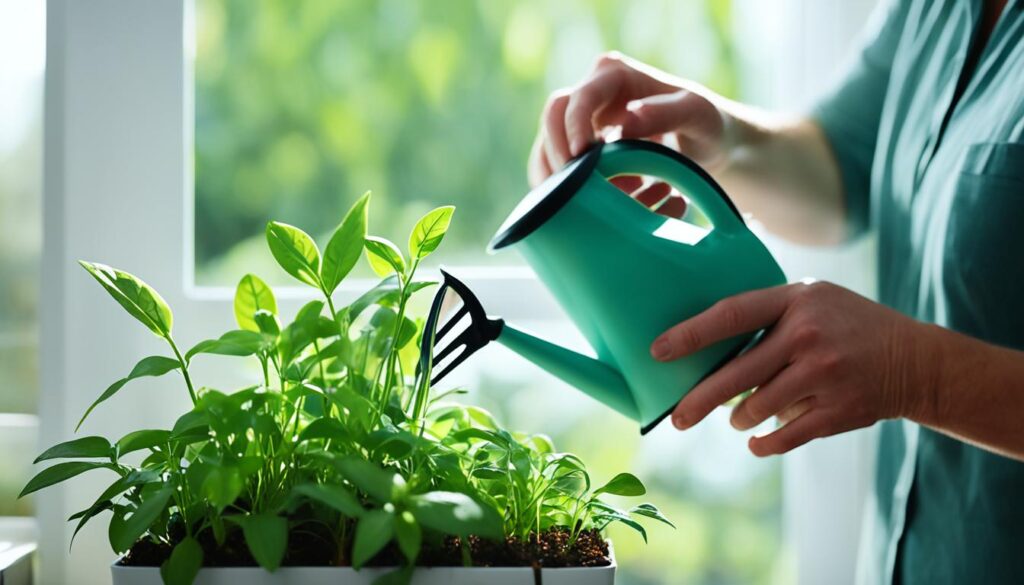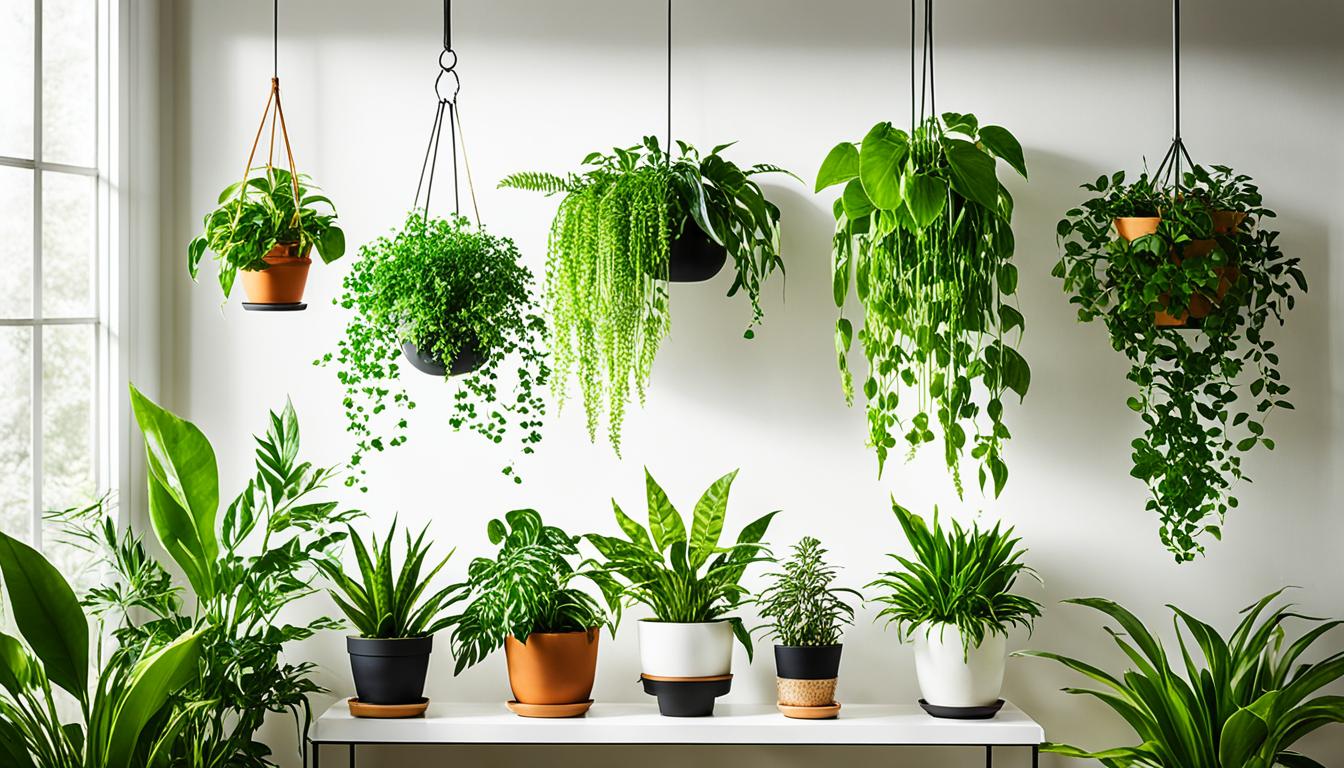Have you ever wondered how to create a truly pure and fresh environment in your home? With indoor air being 2-5 times more polluted than outdoor air, it’s crucial to find effective solutions to improve air quality.
Introducing air-purifying indoor plants – nature’s secret weapon against toxins and pollutants lurking in your living space. These houseplants not only add a touch of green to your décor but also actively clean the air you breathe.
In this comprehensive guide, we will explore the fascinating world of air-purifying indoor plants. From understanding how plants purify the air to discovering the best plants for your home, you’ll gain valuable insights and practical tips to transform your space into a cleaner, healthier haven.
Key Takeaways:
- Air-purifying indoor plants can significantly reduce toxins and improve air quality in your home.
- Plants use photosynthesis to clean the air and absorb airborne toxins like formaldehyde and benzene.
- Choose pet-friendly air-purifying plants if you have furry friends at home.
- Top air purifying plants include bamboo palm, spider plant, gerbera daisy, snake plant, chrysanthemum, peace lily, and aloe vera.
- Air-purifying plants offer various benefits, including reducing irritation, lowering stress, and improving attention capacity.
How do Plants Purify Air?
Plants have a remarkable ability to purify the air through a process called photosynthesis. During photosynthesis, plants take in carbon dioxide from the air and release oxygen as a byproduct. This natural process helps to cleanse and refresh the surrounding air, making it healthier for you to breathe.
But the benefits don’t stop there. Certain plants also have the ability to absorb other harmful airborne toxins, such as volatile organic compounds (VOCs). VOCs, including chemicals like benzene, formaldehyde, and ammonia, are commonly found in household products, furniture, and building materials.
By introducing air-purifying plants into your home or workspace, you can effectively reduce the levels of these toxins in the air, creating a more pleasant and healthier environment to live or work in.
Low-Light Air Purifying Plants
When it comes to indoor air purification, low-light air purifying plants are particularly valuable. These plants are able to thrive in environments with limited natural sunlight, making them a perfect choice for areas like bedrooms and offices with minimal windows.
- Snake Plant (Sansevieria trifasciata)
- Peace Lily (Spathiphyllum)
- English Ivy (Hedera helix)
- Spider Plant (Chlorophytum comosum)
These low-light air purifying plants not only contribute to cleaner air but also add a touch of greenery to your space, creating a more soothing and calming atmosphere.
While air purifier machines are effective at removing solid airborne particles, such as dust and pet dander, combining them with air-purifying plants can enhance the overall air cleaning process by filtering out toxins and VOCs.
Air Purifying Plants for Homes with Pets
When it comes to choosing air-purifying plants for your home, pet owners need to consider the safety of their furry friends. Some plants can be harmful or toxic to cats and dogs if ingested. To create a safe environment for both your pets and your indoor air quality, here are some air purifying plants that are pet-friendly:
“It’s crucial to choose air-purifying plants that are non-toxic to cats and dogs.”
- Boston Fern: This air purifying plant is safe for pets and can help remove formaldehyde from the air.
- Money Tree: Not only does it bring good luck, but this plant is also non-toxic to pets and improves indoor air quality.
- Prayer Plant: The prayer plant is a beautiful option that is safe for cats and dogs, helping to eliminate toxins like benzene.
While these plants are safe for pets, there are certain air-purifying plants that should be avoided if you have cats or dogs. Plants such as snake plants, rubber plants, English ivy, and aloe vera can be toxic to pets if ingested.
Remember to place the pet-friendly air purifying plants in areas that are out of reach for your pets. This will help ensure their safety while improving the air quality of your home.
| Safe Air Purifying Plants for Homes with Pets | Unsafe Air Purifying Plants for Homes with Pets |
|---|---|
| Boston Fern | Snake Plant |
| Money Tree | Rubber Plant |
| Prayer Plant | English Ivy |
| Aloe Vera |
What Plants Purify Air? Top Air Purifying Plants for Indoor Spaces
When it comes to improving indoor air quality, air purifying plants are a natural and effective solution. These plants have the ability to filter and remove toxins from the air, creating a cleaner and healthier environment for you and your loved ones. If you’re looking to bring the benefits of air purification into your indoor spaces, consider incorporating the following top air purifying plants:
Bamboo Palm
The bamboo palm is a popular choice for indoor spaces as it can effectively filter formaldehyde, benzene, xylene, and chloroform. Not only does it improve air quality, but it also adds a touch of tropical beauty to your home or office.
Spider Plant
The spider plant is known for its ability to absorb formaldehyde and xylene from the air. It is a low-maintenance plant that is perfect for beginners and can be easily grown in a variety of indoor environments.
Gerbera Daisy
The gerbera daisy not only adds a pop of color to your space but also helps to improve air quality by removing benzene and formaldehyde. Additionally, this beautiful flower has been found to have mood-boosting properties, making it a perfect choice for brightening up your indoor spaces.
Snake Plant
The snake plant is a popular choice for indoor air purification as it is known to eliminate formaldehyde, benzene, toluene, and trichloroethylene. However, it is important to note that the snake plant can be toxic to pets, so it is best suited for pet-free households or placed out of reach of curious animals.
Chrysanthemum
The chrysanthemum is not only a beautiful flower but also an excellent air purifier. It can remove ammonia and benzene from the air, making it a great choice for improving indoor air quality.
Peace Lily
The peace lily is a popular choice for indoor spaces with low sunlight. It is known for its ability to purify formaldehyde and benzene, making it an excellent option for pet-free rooms that receive minimal natural light.
Aloe Vera
Aloe vera is not only renowned for its soothing properties but also for its ability to purify formaldehyde and benzene from the air. This versatile plant thrives in a variety of indoor environments and adds a touch of greenery to your living space.
By incorporating these air purifying plants into your indoor spaces, you can enjoy cleaner and fresher air while adding beauty and tranquility to your surroundings.
Benefits of Air-Purifying Plants
Air-purifying plants offer several benefits that can significantly improve the quality of the air in your home. By incorporating these plants into your indoor spaces, you can experience a range of advantages that contribute to a healthier living environment.
Reducing Irritation and Respiratory Issues
One of the key benefits of air-purifying plants is their ability to reduce irritation to the eyes, ears, nose, and throat, making the air more comfortable to breathe. These plants can also help prevent or alleviate coughing and congestion, providing relief for respiratory conditions.
Lowering Stress Levels and Improving Attention
Studies have shown that the presence of indoor plants, including air-purifying plants, can have a calming effect, reducing stress levels and promoting a sense of well-being. Additionally, the visual appeal and presence of nature in your surroundings can enhance concentration and improve attention capacity.
Reducing Carbon Dioxide and Increasing Relative Humidity
Air-purifying plants actively absorb carbon dioxide from the air through the process of photosynthesis. This leads to a decrease in CO2 levels indoors, creating a more balanced and oxygen-rich environment. Additionally, these plants act as natural humidifiers, helping to increase relative humidity and reduce dryness in the air, particularly during the winter months.
Eliminating Stale Air and Promoting Better Air Quality
Air-purifying plants play a crucial role in eliminating stale air by filtering out pollutants and releasing fresh oxygen. They can effectively remove toxins and volatile organic compounds (VOCs), such as benzene and formaldehyde, commonly found in household items and cleaning products. By doing so, these plants promote better air quality, providing you with a healthier living space.
By introducing air-purifying plants into your home, you can reap the benefits of improved indoor air quality, ranging from a reduction in irritation and respiratory issues to increased attention capacity and overall well-being. These plants act as natural filters, purifying the air you breathe and creating a more harmonious and inviting atmosphere.
| Benefits | Description |
|---|---|
| Reducing Irritation and Respiratory Issues | Helps reduce irritation to the eyes, ears, nose, and throat, and prevent or ease coughing and congestion. |
| Lowering Stress Levels and Improving Attention | Creates a calming environment, lowering stress levels, and enhancing concentration and attention capacity. |
| Reducing Carbon Dioxide and Increasing Relative Humidity | Active absorption of carbon dioxide, leading to decreased CO2 levels, and acting as natural humidifiers to increase relative humidity. |
| Eliminating Stale Air and Promoting Better Air Quality | Filters out pollutants and toxins, eliminating stale air and improving overall air quality in your home. |

The NASA Clean Air Study
The NASA Clean Air Study was conducted to explore natural ways to purify air in small and unventilated spaces, such as space stations. NASA tested various houseplants and found that some plants, like English Ivy and Spider Plant, were effective at absorbing pollutants like formaldehyde, benzene, xylene, ammonia, and trichloroethylene. These findings highlight the potential of indoor plants to purify air in homes and improve air quality.
Using Houseplants to Enhance Air Quality at Home
Incorporating houseplants in your home can help enhance air quality by reducing levels of toxins and pollutants. Indoor plants have the natural ability to absorb volatile organic compounds (VOCs) that are commonly found in items like furniture, paint, and cleaning products. By having houseplants in your living space, you can enjoy cleaner and purer air, potentially improving your overall well-being.
Houseplants act as natural filters, effectively removing pollutants and toxins from the air. They can help rid your home of harmful substances such as benzene, formaldehyde, and trichloroethylene, which are often released by common household items. By reducing the presence of these chemicals, houseplants create a healthier environment for you and your family.
Houseplants have been shown to reduce levels of toxins and pollutants in the air, enhancing indoor air quality and promoting a healthier living space.
Not only do houseplants help eliminate toxins, but they also release oxygen and increase humidity in the air. This can help alleviate dryness and improve respiratory health. In fact, studies have shown that the presence of houseplants can reduce symptoms of allergies, asthma, and other respiratory conditions.
When choosing houseplants for air quality improvement, consider options such as the Peace Lily, Spider Plant, Snake Plant, and Boston Fern. These plants are known for their ability to absorb pollutants and enhance air quality.
| Houseplant | Air-Purifying Ability |
|---|---|
| Peace Lily | Removes formaldehyde, benzene, and trichloroethylene |
| Spider Plant | Absorbs formaldehyde and xylene |
| Snake Plant | Eliminates benzene, formaldehyde, toluene, and trichloroethylene (toxic to pets) |
| Boston Fern | Filters formaldehyde and xylene |
These houseplants not only enhance air quality but also add beauty and nature to your home decor. By bringing the outdoors inside, you create a more inviting and refreshing living space.
Remember to properly care for your houseplants to ensure their optimal air-purifying benefits. Provide them with adequate sunlight, water, and attention to promote their growth and longevity.

Creating a Healthy Home with NASA-Approved Plants
NASA has approved various plants that can enhance the well-being of your home by purifying the air. Incorporating these plants into different rooms can not only beautify your space but also improve indoor air quality, benefiting both you and your family.
If you want to create a healthy home environment, NASA recommends having at least one plant every 100 square feet. By strategically placing these NASA-approved plants in different areas, you can effectively purify the air and enhance your overall well-being.
Living Room:
In the living room, consider plants like the Areca Palm and Dragon Tree. These plants are not only aesthetically pleasing but also highly effective at removing pollutants from the air. They can eliminate harmful toxins and produce oxygen, creating a fresh and clean atmosphere for you and your loved ones to relax in.
Home Office:
In your home office, you can benefit from the air purification properties of the Money Plant. Also known as the Devil’s Ivy, this plant is an excellent choice for improving air quality. Its ability to remove toxins from the air can help create a healthier workspace, allowing you to breathe in cleaner air while you work.
Children’s Playroom:
For the children’s playroom, it’s important to choose non-toxic plants that can help clean the air without posing a risk to little ones. Spider Plants are a great option as they are safe for children and pets. These plants can effectively reduce pollutants in the air, allowing your kids to play and breathe in cleaner air.
Bedroom:
The bedroom is a place where we spend a significant amount of time resting and recharging. Plants like Mother-In-Law’s Tongue (Snake Plant) are ideal for the bedroom as they continue to produce oxygen throughout the night. This can contribute to better sleep quality and improved air quality, creating a healthier environment for you to unwind and recharge.
By incorporating NASA-approved plants into different areas of your home, you can create a healthier and more enjoyable living space. These plants not only enhance the aesthetic appeal but also actively purify the air, providing numerous benefits for your well-being.
Remember, NASA-approved plants have been scientifically proven to enhance air purification and overall well-being. So go ahead and bring a touch of nature into your home to experience the refreshing benefits of cleaner, healthier air.
How to Care for Air-Purifying Plants
Different air-purifying plants have various care requirements. To ensure optimal growth and air-purifying benefits, it’s essential to provide adequate watering, sunlight, and maintenance. By following these guidelines, you can help your air-purifying plants thrive and continue to improve the air quality in your home.
Watering
Proper watering is crucial for the health of your air-purifying plants. While the watering frequency may vary depending on the specific plant, it’s generally recommended to water the plants when the top inch of soil feels dry to the touch. Avoid overwatering, as this can lead to root rot and other issues. It’s always better to underwater than overwater, so monitor the moisture level of the soil and adjust your watering schedule accordingly.
Note: Different air-purifying plants may have different water requirements. It’s important to research the specific needs of each plant to ensure proper watering.
Sunlight
Sunlight plays a vital role in the growth and development of air-purifying plants. Most plants thrive in bright, indirect light. Place your plants near a window where they can receive sufficient sunlight, but avoid exposing them to direct sunlight for extended periods, as this can lead to sunburn and damage the leaves. If you have low-light air-purifying plants, such as snake plants, make sure they still receive some natural light throughout the day.
Note: Different air-purifying plants may have different light requirements. Research the specific needs of each plant to ensure proper sunlight exposure.
Maintenance
To ensure the longevity and effectiveness of your air-purifying plants, regular maintenance is essential. Here are some key maintenance tasks:
- Pruning: Trim any dead or yellowed leaves to promote healthy growth.
- Fertilizing: Some plants, like the Areca Palm and Dragon Tree, benefit from regular fertilization. Use a balanced houseplant fertilizer according to the instructions on the label.
- Dusting: Dust can accumulate on the leaves, hindering photosynthesis. Wipe the leaves gently with a damp cloth to keep them clean and free from dust.
Note: Each air-purifying plant may have specific maintenance requirements. Ensure you understand and follow the maintenance guidelines for each plant in your care.
By providing proper watering, sunlight, and maintenance, you can enjoy the benefits of air-purifying plants while creating a healthier and more beautiful indoor environment.

The Future of Air-Purifying Plants
Scientists have been diligently working on advancing the capabilities of air-purifying plants through genetic modification. This groundbreaking research aims to enhance the natural air-cleansing properties of plants, offering even more effective solutions for improving indoor air quality.
One notable example is the genetically modified pathos ivy, which has undergone rigorous testing by researchers. This remarkable plant has demonstrated significant reductions in the levels of chloroform and benzene, two harmful pollutants commonly found in indoor environments.
Currently, the pathos ivy is available in Canada, where it has garnered attention for its exceptional air-purifying abilities. However, researchers are actively seeking approval from the Department of Agriculture to make this powerful plant accessible to households across the United States.
The future of air-purifying plants holds tremendous potential for revolutionizing indoor air quality. As scientists continue to explore and refine genetic modification techniques, we can expect to see an array of innovative plant varieties that possess enhanced air-cleansing properties.
By harnessing the power of genetically modified plants, we can pave the way for a greener and healthier future. These advanced air-purifying plants have the capacity to eliminate harmful toxins and pollutants, ultimately creating cleaner and safer indoor environments.
Investing in the future of air-purifying plants means investing in the well-being of you and your loved ones. As these advancements continue to unfold, we can look forward to an even brighter and cleaner future, where the air we breathe is truly pure.
Conclusion
Air-purifying indoor plants offer a natural and effective solution to improve the air quality in your home. By bringing in the right plants for each room, you can create a healthier and more refreshing living environment. Whether you choose to place the Areca Palm in your living room, the Money Plant in your home office, or the Snake Plant in your bedroom, these air-purifying plants not only add beauty but also contribute to purer air.
Indoor air can be highly polluted, but air-purifying plants have the ability to reduce toxins and pollutants, creating a cleaner space for you and your family. The Areca Palm, for example, can filter formaldehyde, benzene, xylene, and chloroform, while the Snake Plant eliminates formaldehyde, benzene, toluene, and trichloroethylene. By introducing these plants to your indoor spaces, you can significantly improve the quality of the air you breathe.
Make the choice to prioritize your well-being and embrace the benefits of air-purifying indoor plants. Not only will they enhance the aesthetics of your home, but they will also enhance your overall health and quality of life. Take the step towards pure air and let air-purifying plants be a part of your journey to a healthier home environment. Give yourself and your loved ones the gift of fresh, clean air by incorporating air-purifying indoor plants into your living spaces.
For more valuable Expert Tips check out our comprehensive Houseplant Guide to Tips for Indoor Plant Care.
If you happen to be nearby, stop in at The Landscape Connection and say Hi. Michelle and I would love to meet you.
FAQ
How do plants purify air?
Plants use photosynthesis to clean the surrounding air by taking in carbon dioxide and releasing oxygen. Some plants can also absorb other airborne toxins, including volatile organic compounds (VOCs) like benzene, formaldehyde, and ammonia. Low-light air purifying plants are especially valuable for indoor air purification. While air purifier machines are effective at removing solid airborne particles, supplementing with plants can enhance the air cleaning process.
What air purifying plants are safe for homes with pets?
When choosing air-purifying plants for homes with pets, it’s important to consider the plants’ toxicity to animals. Some plants, like the Boston fern, money tree, and prayer plant, are safe for cats and dogs. However, other plants, such as snake plants, rubber plants, English ivy, and aloe vera, should be avoided if you have pets.
What are some top air-purifying plants for indoor spaces?
There are several air purifying plants that are effective for indoor spaces. Some top options include the bamboo palm, which filters formaldehyde, benzene, xylene, and chloroform; the spider plant, which absorbs formaldehyde and xylene; the gerbera daisy, which removes benzene and formaldehyde while improving mood; the snake plant, which eliminates formaldehyde, benzene, toluene, and trichloroethylene (toxic to pets); the chrysanthemum, which eliminates ammonia and benzene; the peace lily, a great choice for pet-free rooms with low sunlight; and aloe vera, which purifies formaldehyde and benzene.
What are the benefits of air-purifying plants?
Air-purifying plants offer several benefits, including reducing irritation to the eyes, ears, nose, and throat, preventing or easing coughing and congestion, lowering stress levels, improving attention capacity, reducing CO2 levels, and increasing relative humidity. They act as natural humidifiers and help eliminate stale air, promoting better air quality.
What is the NASA Clean Air Study?
The NASA Clean Air Study was conducted to explore natural ways to purify air in small and unventilated spaces, such as space stations. NASA tested various houseplants and found that some plants, like English Ivy and Spider Plant, were effective at absorbing pollutants like formaldehyde, benzene, xylene, ammonia, and trichloroethylene. These findings highlight the potential of indoor plants to purify air in homes and improve air quality.
How can houseplants be used to enhance air quality at home?
Incorporating houseplants in your home can help enhance air quality by reducing levels of toxins and pollutants. Indoor plants can absorb volatile organic compounds (VOCs) present in items like furniture, paint, and cleaning products. By having plants in your home, you can enjoy cleaner and purer air, potentially improving your overall well-being.
What are some NASA-approved plants for enhancing well-being and air purification?
NASA recommends having at least one plant every 100 square feet. Different NASA-approved plants are suitable for various rooms in your home. For the living room, plants like the Areca Palm and Dragon Tree are effective at removing pollutants and producing oxygen. In the home office, the Money Plant is a great choice for air purification. For the children’s playroom, non-toxic plants like Spider Plants can help clean the air. In the bedroom, plants like Mother-In-Law’s Tongue (Snake Plant) continue to produce oxygen at night, aiding in better sleep and air quality.
How should air-purifying plants be cared for?
Different air-purifying plants have various care requirements. It’s essential to provide adequate watering, sunlight, and maintenance for optimal growth and air-purifying benefits. Plants like Areca Palm and Dragon Tree may require regular watering and fertilization. Money Plants can thrive in indirect light and need watering every 1-2 weeks. Spider Plants are thirstier and should be watered about once a week. Snake Plants tolerate most light levels and require less frequent watering. Proper care ensures the plants‘ longevity and effectiveness in purifying the air.
What is the future of air-purifying plants?
Scientists have been working on genetically modifying plants to enhance their air-purifying abilities further. The modified pathos ivy, tested by researchers, showed significant reductions in chloroform and benzene levels. While this powerful air-purifying plant is currently available in Canada, researchers are seeking approval from the Department of Agriculture for its sale in the United States. The future of air-purifying plants holds the potential for even more effective ways to improve indoor air quality.




Pingback: African Violet, The Compact Flowering Plant That Blooms Year-Round Indoors